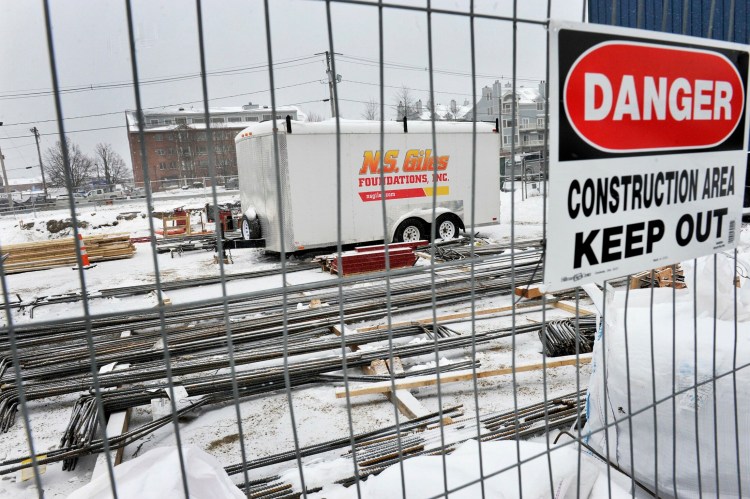Maine appears to be nearing the end of an economic expansion that brought several years of rapid growth in commercial and residential real estate activity, according to industry experts.
Analysts at a Maine Real Estate and Development Association, or MEREDA, conference Tuesday in Portland pointed to an accelerating decline in commercial real estate activity as a sign that the state’s relatively hot economy, particularly in its southern region, is cooling down.
Commercial real estate activity – the amount of buying, leasing and construction of properties for commercial use – is considered a leading economic indicator, meaning that it tends to move in a particular direction before the rest of the economy follows. That’s in large part because companies tend to buy, lease and build commercial properties when they are expecting to thrive, expand and hire.
The commercial real estate component of the MEREDA Index, a quarterly measure of Maine’s real estate economy, declined 7.4 percent in the first quarter compared with six months earlier. Commercial sale and lease transactions dropped by 13 percent, and total square footage leased and sold fell by 41 percent, it said. However, the price per square foot of commercial properties sold decreased by 10 percent, but the price of leased space rose by 15 percent.
While the commercial index tends to fluctuate throughout the year, the index is seasonally adjusted and has been trending downward since its most recent peak in early 2016, and the decline has accelerated recently.
“We’re at the tail end of a long period of market expansion,” said MEREDA Index analyst Joseph Porta, broker and manager of commercial real estate firm Porta & Co. in Portland.

Porta said investors in Maine commercial real estate need to be thinking about ways to hedge their risks, adding that the one bright spot in the commercial sector is multifamily housing, which is expected to see continued demand.
Overall, the first quarter’s MEREDA Index, which includes commercial, residential and construction components, fell by 2 percent over the previous six months and by 3.4 percent over the previous year. The index, compiled by Charles Colgan of the Maine Center for Business and Economic Research at the University of Southern Maine, was dragged down primarily by the decline in commercial real estate activity. The index is based around quarterly real estate data from Portland commercial real estate firm The Boulos Co. and relies on a six-month comparison to track the real estate market’s ups and downs.
Analysts at Tuesday’s conference said the overall index peaked in 2016 and is now at a point roughly equivalent to the baseline economic conditions when they first started measuring it at the beginning of 2006 – about two years before the Great Recession hit. They were quick to note that the recent decline does not presage a similar type of economic crash.
“I think that though we’re late in the (economic) cycle and we see in Charlie Colgan’s latest numbers a downswing in commercial activity that probably indicates the likelihood that there’s fraying in the late-cycle market,” said MEREDA Index analyst Tim Soley, president of real estate firm East Brown Cow Management Inc. in Portland.
Still, Soley said that fraying doesn’t signal the end of opportunity for real estate investors, particularly in the Portland area where the long-term outlook remains strong. What it does mean is that certain phenomena consistent with a rising economy are no longer present, he said. As examples, Soley cited the recent slowdowns in condominium sales and leasing of small office spaces.
Consumer demand remains high in Maine’s residential real estate market, but the lack of housing inventory is causing the market’s growth to stall, as people who’d like to sell their homes aren’t doing so because there’s little housing available for them to buy, said MEREDA Index analyst Elise Kiely, senior vice president of Legacy Properties Sotheby’s International Realty.
New home construction is the solution, Kiely said, but the costs have become prohibitively high.
“New construction prices are so expensive, the cost has risen so dramatically, that it’s making that housing inventory harder to satisfy,” she said.
The MEREDA Index’s residential component increased by 4.6 percent in the first quarter compared with six months earlier, buoyed by a 6.5 percent increase in residential building permits and an 8.5 percent rise in home mortgage loans issued. However, sales of existing homes declined by 4.3 percent.
The index’s construction component, which tracks employment in the construction industry, was up 3.8 percent in the first quarter from six months earlier and reached its highest point since the depths of the Great Recession in the first quarter of 2009. However, it remained below pre-recession levels.
Index analyst Richard Brescia, vice president of Pittsfield-based construction firm Cianbro, said the industry’s current challenges include finding affordable construction materials and hiring qualified employees and subcontractors to do the work. Brescia said the sharp rise in construction prices is a relatively recent phenomenon.
“This doesn’t go back very far – you can go back 12 months and look at the pricing 12 months ago versus today, and there’s an increase,” he said. “It’s putting pressure on projects that used some of the older pricing to determine their economics and the viability of that project.”
Brescia said contractors are working to bring prices back down by increasing their efficiency. For example, he said they are doing more work with modular construction techniques that involve manufacturing pieces of a building rather than starting from scratch at the construction site.
“We’re really taking (building information modeling) to a new level … to figure out how can we maximize the work that’s done in a shop locally so when it arrives at the job site, there’s less labor on the job site,” he said.
This story was updated at 10:45 a.m. May 9 to correct the change in price per square foot of commercial properties sold and the spelling of Elise Kiely’s name.
Send questions/comments to the editors.




Comments are no longer available on this story